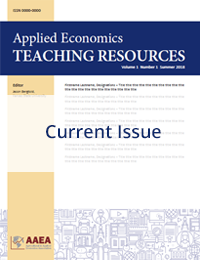Teaching and Educational Methods
Learning about Consumer Demand from Student Surveys
Scott M. Swinton
Michigan State University
JEL Codes: A22, D12, Y1
Keywords: Active learning, demand curve, student survey, teaching microeconomics, willingness to pay
First Published Online: July 21, 2021
volume 3, Issue 3
View Full Article (PDF) | Request Teaching Notes/Supplemental Materials
Abstract
Active learning can help students to grasp abstract economic concepts and become acquainted with quantitative data analysis. This paper describes how a survey of willingness to pay for pizza that is designed, executed, analyzed, and interpreted by students can motivate learning about consumer demand. The approach, which can be adapted to other consumption goods, builds understanding of consumer demand from the level of the individual to the market.
References
Baye, M.R., and J.T. Prince. 2017. Managerial Economics and Business Strategy, 9th ed. New York: McGraw-Hill.
Bergstrom, T.C., and J.H. Miller. 2000. Experiments with Economic Principles: Microeconomics, 2nd ed. New York:Irwin/McGraw-Hill.
Brauer, J., and G. Delemeester. 2001. “Games Economists Play: A Survey of Non-Computerized Classroom-Games for College Economics.” Journal of Economic Surveys 15(2):221–236.
Brock, J.R. 1992. “Experimental Derivation of a Demand Curve.” Classroom Expernomics 1(2):3–4. https://academic.marietta.edu/people/delemeeg/expernom/issues/Fall1992.pdf.
Bruno, C.C., and B.L. Campbell. 2016. “Students’ Willingness to Pay for More Local, Organic, Non-GMO and General Food Options.” Journal of Food Distribution Research 47(3):32–48.
Champ, P.A., K.J. Boyle, and T.C. Brown, eds. 2003. A Primer on Nonmarket Valuation. Dordrecht, Netherlands: Kluwer.
Delemeester, G., and J. Brauer. 2000. “Games Economists Play: Noncomputerized Classroom Games.” Journal of Economic Education 31(4):406–406. Games at: https://academic.marietta.edu/people/delemeeg/games/.
Eber, N. 2003. “Jeux pédagogiques: vers un nouvel enseignement de la science économique.” Revue d'économie politique 113(4):485–521.
Elliott, M.S., and L.M. Elliott. 2020. “Using Data Analytics and Decision-Making Tools for Agribusiness Education.” Applied Economics Teaching Resources 2(2):38–50.
Gillespie, J.M., and M. Bampasidou. 2018. “Designing Agricultural Economics and Agribusiness Undergraduate Programs.” Journal of Agricultural and Applied Economics 50(3):319–348.
Hawtrey, K. 2007. “Using Experiential Learning Techniques.” Journal of Economic Education 38(2):143–152.
Hill, C. 2001. “A Classroom Game for Developing Market Demand and Demand Elasticities: The Snicker Effect.” Classroom Expernomics 10:193–203.
Holt, C.A. 1999. “Teaching Economics with Classroom Experiments.” Southern Economic Journal 65(3):603–610.
Holt, C.A. 2012. “Computer Programs for Classroom Games.” University of Virginia Department of Economics. http://www.people.virginia.edu/~cah2k/programs.html.
Louviere, J.J., and T. Islam. 2008. “A Comparison of Importance Weights and Willingness-to-Pay Measures Derived from Choice-Based Conjoint, Constant Sum Scales and Best–Worst Scaling.” Journal of Business Research 61(9):903–911.
Thomas, E.H., and N. Galambos. 2004. “What Satisfies Students? Mining Student-Opinion Data with Regression and Decision Tree Analysis.” Research in Higher Education 45(3):251–269.
Weidenaar, D.J. 1972. “A Classroom Experiment Demonstrating the Generation of a Market Demand Function and the Determination of Equilibrium Price.” Journal of Economic Education 3(2):94–100.
Articles in this issue
Teaching by the Case Method to Enhance Graduate Students Understanding and Assessment of Wicked-Type Problems: An Application Involving the Bears Ears National Monument
Amanda J. Harker Steele and John C. Bergstrom
Seeds of Learning: Uncertainty and Technology Adoption in an Ecosystem-Based Adaptation Game
Babatunde Abidoye, Sahan T.M. Dissanayake, and Sarah A. Jacobson
Managing a Multiuse Resource with Payments for Ecosystem Services: A Classroom Game
Lauriane S. Yehouenou, Stephen N. Morgan, and Kelly A. Grogan
Making Learning about Climate Change Fun and Interactive
Misti D. Sharp and Jada M. Thompson
What does the pandemic mean for experiential learning? Lessons from Latin America
Grace Melo, Dérgica Sanhueza, Sarahi Morales, and Luis Peña-Lévano
Learning about Consumer Demand from Student Surveys
Scott M. Swinton


